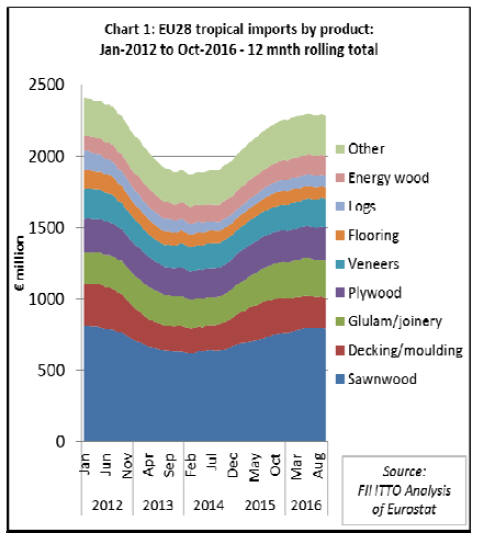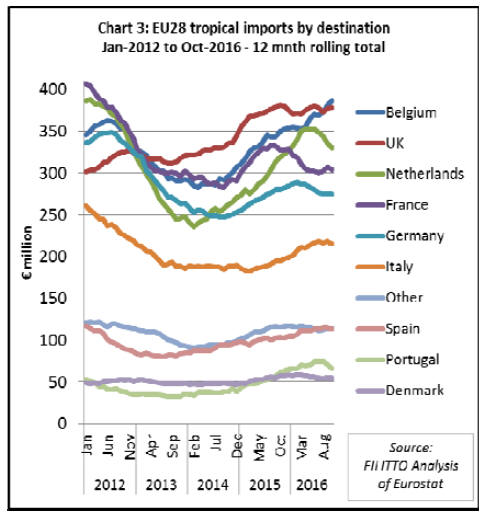|
Report from
Europe
Slowing pace of EU tropical timber imports
Latest trade data shows that the rising trend in the value of
EU imports of tropical wood products that began in the
second half of 2014 levelled off in 2016.
The stability in the euro value of tropical wood imports in
the second half of 2016 may hide a slight fall in the
volume of imports as European currencies weakened on
foreign exchange markets during that period (which
implies a rise in import prices).
The euro, trading at around US$1.15 in June 2016, had
fallen to only US$1.05 by the end of the year. Even more
pronounced is the fall in the British pound, which was
trading at US$1.50 in June just before the country’s vote
to leave the EU before declining to a 30-year low of
US$1.29 in early July after the result and which now
stands at just US$1.23.
Nevertheless, the dramatic slowdown in European tropical
wood imports forecast for the second half of 2016 in
response to currency movements and economic
uncertainty in the UK following the Brexit vote failed to
materialise. Prospects for the market in 2017 also look
reasonably positive.
While the political situation in Europe is still uncertain,
the economic recovery is gathering pace, helped by an
improving global outlook, low interest rates, a significant
fall in the level of unemployment, a weak euro and the end
of austerity.
Charts 1 to 3 below show the monthly trend in imports of
tropical wood products into the EU up to the end of
October 2016 using 12 month rolling totals.
This is calculated for each month as the total import of the
previous 12 months. The data removes short-term
fluctuations due to seasonal changes in supply and
shipping schedules and provides a clear indication of the
underlying trade trend.
Chart 1 shows total EU euro import value of all wood
products listed in Chapter 44 of the HS codes sourced
from tropical countries. Total imports in the 12 months to
October 2016 were euro 2.29 billion, slightly above euro
2.26 billion recorded for the 12 months of 2015.
European imports of tropical veneer, plywood, and energy
wood continued to rise slowly between January and
October 2016. European imports of tropical sawnwood,
LVL and logs, which were rising in the first half of 2016,
stabilised at the higher level in the second half of the year.
However, imports of tropical decking and mouldings,
which increased sharply in 2015, were sliding throughout
2016.

Chart 2 shows how European imports from the major
tropical supply countries developed between 2012 and
October 2016.
After rapid growth in 2015 and the first quarter of 2016,
European imports from Indonesia (dominated by decking,
doors, plywood and LVL) stabilised at the higher level
between April and October 2016.
Imports from Malaysia (mainly sawnwood, plywood,
doors, and LVL) peaked in May 2016 and fell in the
months to October. Imports from Brazil (mainly
sawnwood and decking) were also sliding in 2017.
However, imports from Cameroon (almost all sawnwood)
and Gabon (a mix of sawnwood, veneer and plywood)
continued to rise in the year to October.

Chart 3 shows the recent trend in tropical wood imports
into the main EU consuming countries. The pace of
growth in imports into the UK (which takes mainly doors,
plywood and sawnwood) was slowing in the early months
of 2016.
Contrary to expectations of a sharp downturn, the euro
value of UK imports stabilised at the higher level in the
months following the Brexit vote in June.
The value of tropical wood imports into Belgium (mainly
sawnwood and decking) increased so rapidly in the year to
October that the country was on course to overtake the UK
as the largest European destination for tropical wood in
2016.
This suggests that the trend towards concentration of
Europe’s tropical imports in the hands of a few large
traders close to main ports continues to intensify - a trend
driven partly by logistics and partly by the risk
management demands of the EU Timber Regulation.
However, the rise in import value into Belgium between
April and October 2016 was mirrored by a sharp decline in
imports into Netherlands during the same period, so these
trends may simply reflect temporary shifts in internal EU
distribution channels between the ports of Rotterdam and
Antwerp.
Meanwhile, direct imports of tropical wood into France
(mainly sawnwood, decking and veneer) and Germany
(mainly decking and sawnwood) were sliding in the
opening months of 2016 but stabilised between July and
October.
The recovery in tropical wood imports by Italy (mainly
sawnwood and veneer), Spain (mainly sawnwood and
veneer) and Portugal (mainly sawnwood, logs and chips)
in the first half of 2016 lost some momentum in the second
half of the year.

Improving economic prospects in Europe
While there are significant downside risks in 2017,
particularly with key national elections due to be held in
Germany, France and the Netherlands, prospects for the
European market seem promising.
Economic surveys show that manufacturing activity and
economic sentiment in the EU increased to their highest
levels since 2011 in the closing months of last year.
By the end of 2016, unemployment in the 19-nation euro
zone had fallen to its lowest point in more than seven
years: 9.8% according to Eurostat compared to over 20% a
year earlier.
The big question in Europe this year is whether fragile
economic growth and unprecedented central-bank stimulus
will be overtaken by populist politics which could threaten
the future of both the euro and the European single market.
But while Europe’s political calendar in 2017 certainly
creates uncertainty, it might also offer opportunities.
In a recent interview for CNBC, Francesco Garzarelli, cohead
of global macro and markets research at Goldman
Sachs noted that a potential right-wing president in France
could lead to a stronger reform agenda in Europe. "If
France were to change gear and become more inclined to
move forward into reforming its economy I think that will
force the likes of Italy, Portugal, Greece to do the same,"
Garzarelli said.
In fact, more economic analysts now seem inclined to give
Europe the benefit of the doubt and are suggesting that
growth will exceed expectations. According to a research
team led by Anais Boussie, writing in the Credit Suisse
European Economics note on 9 January, "The euro area is
set to deliver an upside growth surprise this year. Market
expectations for growth are too low, in our view. Growth
should strengthen on the back of stronger global trade and
a pick-up in construction activity. It should remain
supported by consumer spending, for which the
fundamentals are improving,"
The Credit Suisse team forecast that GDP in the euro-zone
will rise by a sturdy 2.0% in 2017, growth that will be
underpinned by consumer spending. Instead of being
fuelled by things like low oil prices, Credit Suisse reckon
consumer spending will grow thanks to improving
fundamentals like labour demand.
They also note that "construction investment has
contributed positively to growth for the past six quarters,
and appears to be accelerating”.
Credit Suisse are confident that "the risk of deflation in the
euro area has largely disappeared and headline inflation is
set to rise sharply in the first half of 2017 as the strong
dampening effect from past oil price declines fades away."
They also expect that the European Central Bank will be
“dull” (a positive trait after a few too many “interesting”
years) – quantitative easing will continue to provide
greater liquidity at least until the end of the year while the
base interest rate is likely to remain unchanged.
UK economy defies expectations in 2016 but likely to
slow in 2017
Outside the euro-zone (but still a member of the EU for at
least another 2 years), the UK economy defied
expectations in 2016 as Britons decided to keep calm and
carry on spending following the Brexit vote. Growth
showed surprising resilience in the face of fears of
recession with warnings from the Bank of England ahead
of the EU referendum proving unfounded.
Indeed, the UK Office for National Statistics said the
economy grew by 0.5 per cent between July and
September 2016, the three month period after the
referendum.
The UK economy remained buoyant in the last quarter of
the year. The Markit/CIPS UK Manufacturers Purchasing
Managers Index for December rose to 56.1, the strongest
reading since June 2014, and up from 53.6 in November.
A reading above 50 indicates expansion in the sector, with
the month's figure driven up by orders from home and
abroad. The figures put the UK on course to be the fastest
growing economy in the G7 group of leading nations in
2016.
However, this resilience is not expected to last. The British
pound’s plunge in value last year may see growth falter in
2017. Surging prices due to the weaker currency are
widely forecast to bring an end to the consumer spending
spree that has helped prop-up growth since the EU
referendum.
The UK’s Office for Budget Responsibility (OBR)
estimates the economy will take a hit of almost £60 billion
over the coming five years as a result of the Brexit vote.
The OBR has slashed UK growth forecasts and is
predicting higher borrowing than previously expected.
To boost short term growth, the UK government is pinning
its hopes on a big increase in public spending on
infrastructure in a package of measures unveiled in August
last year worth more than £170 billion and on historically
low interest base rate of only 0.25%.
|